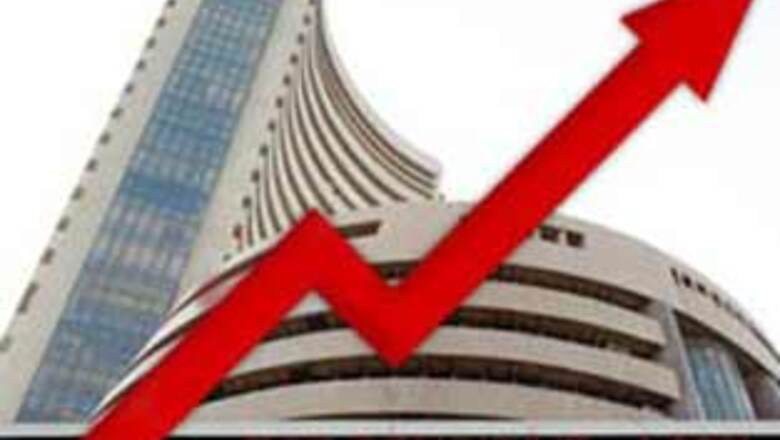
views
Anup Maheshwari of DSP BlackRock Mutual Fund, believes markets are beginning to see pockets of performance.
On the auto sector, he said monthly sales numbers are driving the sector. According to him, pure buy or hold strategy may not be very effective for autos now. He is turning optimistic on commodity space as a lot of commodity stocks are seeing reasonable valuations. "One could look at value buying in some commodities over next 12 months."
He prefers private sector banks over public sector banks on a 12 month period. According to him, global macros are still fluid and there is a scope for 20-25 per cent downside.
Here is a verbatim transcript of the exclusive interview with Anup Maheshwari on CNBC-TV18. Also watch the accompanying video.
Q: What is your sense is this just one of those relief pullbacks or could the market have a constructive shape going into elections or even after that?
A: I think that will be the sign of the times that the next year or so we will see a lot of such trading moves, markets heading up and then coming back off a bit. So I don't think there is anything clear yet to give a sustainable trend and clearly nothing will signal that to us either over the next six or twelve months.
But I think the more important thing is that markets have reached a point where there is some level of sorting out of valuations taking place. So unlike last year where everything was pretty much heading down, I think we are beginning to see pockets of performance coming through sector by sector which in itself is a good sign. I think clearly it doesn't imply that the market bottom has been achieved or not but it makes that pretty relevant because as long as there is some opportunity available in the market place that is what we would be more interested in.
It does seem to be sorting itself out if we take the case of auto or cement or some of the other sectors. I think clearly there are periods where you can actually make a certain amount of money as the valuation sort themselves out.
Q: The other point that is being made aside from this sorting is that for global markets generally things had gotten depressed to such a level that perhaps we saw the last wave of capitulation where there is basically exhaustion in terms of selling, is it too early to call that or would you go with that theory?
A: I think it is a bit early to call that because when everybody is calling the bottom that is not normally how bottoms are made conventionally. So I think just from a time cycle point of view we have got more time coming up. I am not sure whether we will hit a new low or not but the point is the market has to send time in this zone around where it is plus or minus some percentage. But within that time period over the next year or so, I think valuations which have universally got knocked down will start readjusting themselves in coming to slightly more balanced levels. So I think we are in that phase where taking the market call is pretty pointless whether it has bottomed out or not, it is not necessarily as relevant as beginning out whether valuations have got distorted in any sectors and whether things are marginally improving there.
Q: For the autos, what do you think is going for that space, the fact that valuations got as depressed as they did or are you seeing the cycle turning around now?
A: It is a bit of both. Clearly autos had come off a bit but added to that the big catalyst has been the fact that the numbers have turned out to be much stronger than people expected and more resilient. So everyone is keeping a close eye on the monthly numbers, you can measure it regularly. That I think is continuing to drive the sector. The point though about trading markets is that these things didn't get priced in quickly and then the room for upside gets fairly limited. So unfortunately, this is a phase where a pure buy/hold strategy may not be as effective for investors at least in the very near-term because there will be a lot of rotation that keeps taking place. So at some point even autos may see that trend.
Q: Anything other than autos in terms of cyclical sectors which has seen a lot of pain from a stock price perspective which you think might have bottomed out because it is interesting because these are the cyclicals which have suffered for years now in the market, if one by one they start bottoming out, you get to get a sense of hope, anything other than autos that you can single out?
A: I think commodities, is a space that we are turning quite optimistic on. I think a lot of commodity stocks are reasonably priced way below book value now and even global commodities we get the sense that over the next twelve months, you will see some very sharp movements and I think potential for commodity equities to move up are also quite high. So commodities is one space that we have a close eye on and probably make some sense to own at least over the course of next twelve months.
Q: When you talk of commodities, do you mean global commodities like metals or even local ones like cement?
A: I am talking largely of global commodities metals and within metals – virtually all categories – ferrous and aluminium would come at the lower end but copper, zinc seem to be better positioned right now but generally speaking metals as a pack will do reasonably well.
PAGE_BREAK
Q: Can you put your finger on how the money is behaving towards India as a market right now? We have seen a lot by way of short covering, but are people getting into these value buys that we were just talking about or are they still waiting and watching the market?
A: I think we are already seeing some gradual improvement at least the pace of selling has come off dramatically in fact there has been marginal buying now. We are not as negative on FII flows as one would normally tend to be at times like these. Our sense is between now and the end of the year, it may not be as bad as people imagine and I think a lot of these global allocation funds are clearly looking at India. The dedicated funds have been more influenced by inflows and outflows out of their funds but even there the outflows have stemmed down a bit. by global allocation funds who have the choice to move pretty much anywhere in the world, I think on balance at least people we speak to seem to be more inclined to invest than not. So overall I would say the FII activity may surprise a bit on the upside.
Q: Are people waiting to see what happens with Q4 earnings in order to take some kind of investment call or do you think that has more or less discounted?
A: I don't think earnings will be the big influence when valuations the way they are, I think earnings and understanding of earnings is pretty clear to a lot of people. Elections clearly will be one phenomena from an FII perspective that they pay attention to. I don't personally think it makes too much of an economic difference to markets eventually but I think around the event there will always be some volatility, some movement and some FII activity clearly because they do tend to regard this as pretty important event. So I don't think the results will be as much of a mover of the markets as the elections might be.
Q: How are you approaching the financial space as a fund manager, are you underweight or did the recent fall lead you to accumulate many of those names?
A: At a sector level we are still underweight. Within the sector our preference at this point would be for private sector banks over public sector banks again from a twelve month perspective. I think clearly the sector has been under-performing and buffeted by all sorts of concerns and some of those concerns frankly are quite valid and will show themselves true over the next twelve months. But the point is that I think private sector banks clearly have become a lot cheaper, have very stable business characteristics over long periods of time and I think that is a sector we are pretty keen to continue to look at.
Public sector banks on the other hand are something we would rather evaluate six-twelve months down the road. So we own some but we are a little underweight on it right now.
Q: Have we reached the stage in the market where you may not have great upside for many months or quarters but that accumulation zone has begun where you start cherry picking individual stocks and sectors or do you think all sectors still have that overhang of that big market risk where you could see another 20-25 per cent leg down in the market which will inevitably drag every sector down?
A: That is not an easy question to answer for the simple reason that global macros are still very fluid and as long as macro conditions are fluid, the scope for those 20-25 per cent down legs always exist. By that, I mean we are not even sure whether we are heading into more deflation or eventually will have heavy inflation. I think until those macros stabilizes, it is very difficult to give a convincing call on sustainable movement in the markets which is why for the next twelve months we are not convinced that this will be a consistent uptrend, we are still calling it a trading oriented market.
So in that sense, one cannot rule out the possibility of another decline, it is always on the cards, I am not sure what the catalyst could be, I think one thing being talked about globally is currency devaluations across the world and if that picks up in pace that will have implications for global flows as well.
But I have to say as a fund manager and looking at things from a bottom up perspective, there is a fair amount of value out there. There are so many stocks quoting at reasonably good dividend yields way below book that you start wondering whether if you are not going to look at them at this point in time then when on earth you will.
So I think there are opportunities, most of them manifesting themselves in the midcap and smallcap space which is the place that everyone wants to be very far away from right now.
But I think if you can buy and hold for a little while in that space particularly, there is probably some good opportunities there too.
Q: There is the criticism that this accumulation if it is happening is very narrow in nature, do you think that might be the nature of the rallies we see over the course of this year as well that they will be very narrow perhaps very skewed towards one size of capitalization in stocks?
A: I think that is logical to assume. At times like these everyone prefers quality and it is the largecaps that need to move first for any confidence to come back into the small and midcap stocks to move beyond a point. So clearly if you are looking at near-term perspectives, it is logical to think that the bulk of the market movements will be taking place in more liquid, largecap names and midcaps will follow only with a big lag. So I am not saying midcaps necessarily have to perform right away but two-three years down the road when we forget this phase and hopefully things are little better, these stocks could be a lot higher than they are today.
So the timing part is very difficult to gauge. You cannot buy midcaps at perfect time, you have to buy it when others want to sell out of them because that is when they are available. So if there is a bit of a gestation when you buy these stocks, you cannot really expect much in the immediate term. But when the performance does come through, it takes one month in a year for you to cover a year's return.
Disclosure: It is safe to assume that my clients & I may have an investment interest in the stocks/sectors discussed.
















Comments
0 comment